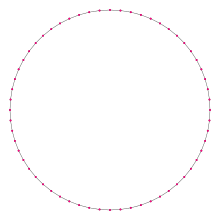Hexacontagon
A hexacontagon or 60-gon is a shape with 60 sides and 60 corners.[1][2]
| Regular hexacontagon | |
|---|---|
 A regular hexacontagon | |
| Type | Regular polygon |
| Edges and vertices | 60 |
| Schläfli symbol | {60}, t{30}, tt{15} |
| Coxeter diagram | |
| Symmetry group | Dihedral (D60), order 2×60 |
| Internal angle (degrees) | 174° |
| Dual polygon | Self |
| Properties | Convex, cyclic, equilateral, isogonal, isotoxal |
Regular hexacontagon
changeA regular hexacontagon is represented by Schläfli symbol {60} and also can be constructed as a truncated triacontagon, t{30}, or a twice-truncated pentadecagon, tt{15}. A truncated hexacontagon, t{60}, is a 120-gon, {120}.
One interior angle in a regular hexacontagon is 174°, meaning that one exterior angle would be 6°.
Area
changeThe area of a regular hexacontagon is (with t = edge length)
and its inradius is
The circumradius of a regular hexacontagon is
This means that the trigonometric functions of π/60 can be expressed in radicals.
Constructible
changeSince 60 = 22 × 3 × 5, a regular hexacontagon is constructible using a compass and straightedge.[3] As a truncated triacontagon, it can be constructed by an edge-bisection of a regular triacontagon.
Dissection
changeCoxeter states that every zonogon (a 2m-gon whose opposite sides are parallel and of equal length) can be dissected into m(m-1)/2 parallelograms. [4] In particular this is true for regular polygons with evenly many sides, in which case the parallelograms are all rhombi. For the regular hexacontagon, m=30, and it can be divided into 435: 15 squares and 14 sets of 30 rhombs. This decomposition is based on a Petrie polygon projection of a 30-cube.
References
change- ↑ Gorini, Catherine A. (2003). The Facts on File Geometry Handbook. Infobase Publishing. p. 78. ISBN 978-1-4381-0957-2.
- ↑ Peirce, Charles Sanders (1976). The New Elements of Mathematics: Algebra and geometry. Mouton Publishers. p. 298. ISBN 9780391006126.
- ↑ Constructible Polygon
- ↑ Coxeter, Mathematical recreations and Essays, Thirteenth edition, p.141
- Eric W. Weisstein, Hexacontagon at MathWorld.
- Naming Polygons and Polyhedra
- Finkel, Benjamin Franklin (1888). A Mathematical Solution Book Containing Systematic Solutions to Many of the Most Difficult Problems: Taken from the Leading Authors on Arithmetic and Algebra, Many Problems and Solutions from Geometry, Trigonometry and Calculus, Many Problems and Solutions from the Leading Mathematical Journals of the United States, and Many Original Problems and Solutions. Kibler.